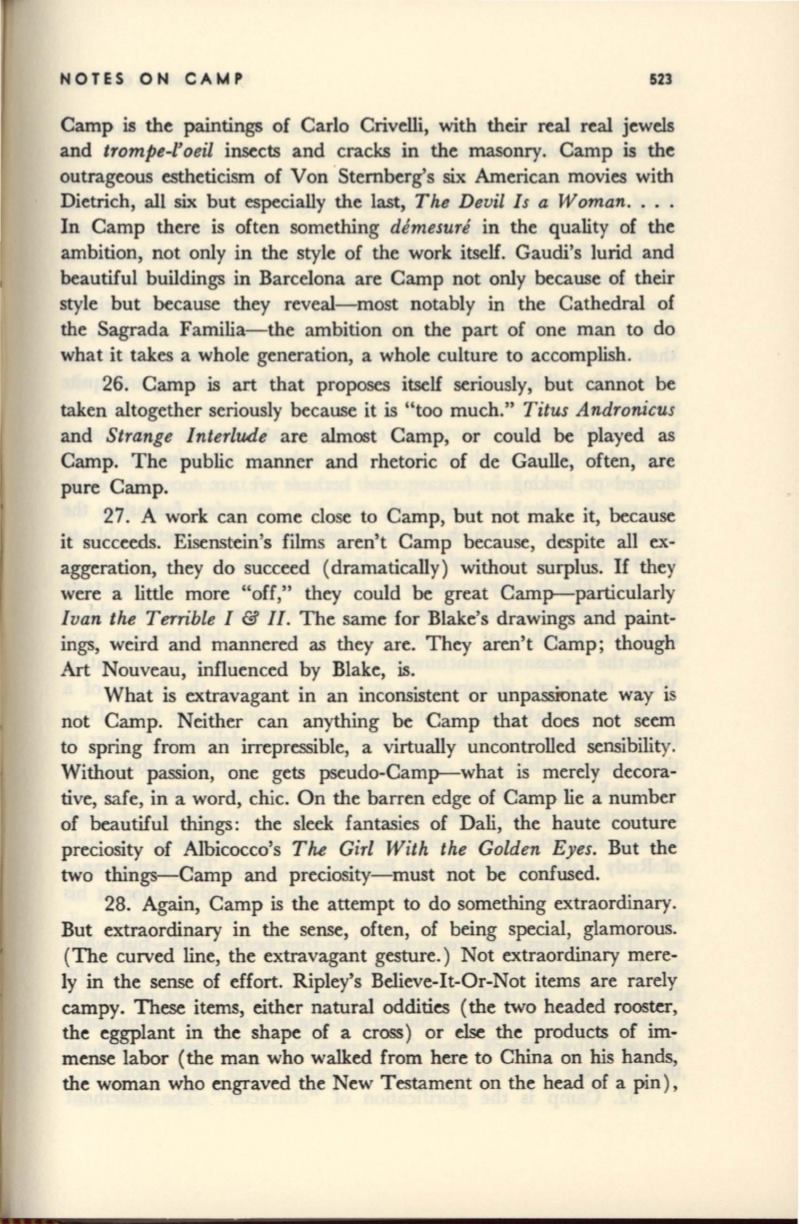

NOTES ON CAMP
523
Camp
is
the paintings of Carlo Crivelli, with their real real jewels
and
trompe-l'oeil
insects and cracks in the masonry. Camp is the
outrageous estheticism of Von Stemberg's
six
American movies with
Dietrich, all six but especially the last,
The Devil Is a Woman .
...
In Camp there is often something
demesure
in the quality of the
ambition, not only in the style of the work itself. Gaudi's lurid and
beautiful buildings in Barcelona are Camp not only because of their
style but because they reveal-most notably in the Cathedral of
the Sagrada Familia-the ambition on the part of one man to do
what it takes a whole generation, a whole culture to accomplish.
26. Camp is art that proposes itself seriously, but cannot be
taken altogether seriously because it is "too much."
Titus Andromcus
and
Strange Interlude
are almost Camp, or could be played as
Camp. The public manner and rhetoric of de Gaulle, often, are
pure Camp.
27. A work can corne close to Camp, but not make it, because
it succeeds. Eisenstein's films aren't Camp because, despite all ex–
aggeration, they do succeed (dramatically) without surplus.
If
they
were a little more "off," they could be great Camp--particularly
Ivan the Terrible I
&
II.
The same for Blake's drawings and paint–
ings, weird and mannered as they are. They aren't Camp; though
Art Nouveau, influenced by Blake, is.
What is extravagant in an inconsistent or unpasslonate way is
not Camp. Neither can anything be Camp that does not seem
to spring from an irrepressible, a virtually uncontrolled sensibility.
Without passion, one gets pseudo-Camp--what is merely decora–
tive, safe, in a word, chic. On the barren edge of Camp lie a number
of beautiful things: the sleek fantasies of Dali, the haute couture
preciosity of Albicocco's
The Girl With the Golden Eyes.
But the
two things-Camp and preciosity-must not be confused.
28. Again, Camp is the attempt to do something extraordinary.
But extraordinary in the sense, often, of being special, glamorous.
(The curved line, the extravagant gesture.) Not extraordinary mere–
ly in the sense of effort. Ripley's Bdieve-It-Or-Not items are rarely
campy. These items, either natural oddities (the two headed rooster,
the eggplant
in
the shape of across) or
else
the products of
im–
mense labor (the man who walked from here to China on his hands,
the woman who engraved the New Testament on the head of a pin),









